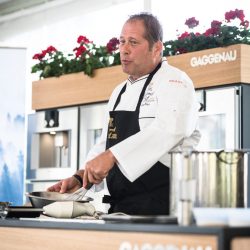 March 20, 2018 – When renowned Michelin star chef, David Kinch of Manresa in Los Gatos, mic’d up to do his cooking demo at GourmetFest in Carmel this past weekend, a rapt hush fell over the audience. Cameras trained in to capture his every move: stalking fame. But Kinch isn’t one to relish it. In fact, he explained that while he’s a cook and a chef, he’s not a public speaker. “Help me out here,” he said, “and ask me questions while I’m working. It makes me less nervous.”
March 20, 2018 – When renowned Michelin star chef, David Kinch of Manresa in Los Gatos, mic’d up to do his cooking demo at GourmetFest in Carmel this past weekend, a rapt hush fell over the audience. Cameras trained in to capture his every move: stalking fame. But Kinch isn’t one to relish it. In fact, he explained that while he’s a cook and a chef, he’s not a public speaker. “Help me out here,” he said, “and ask me questions while I’m working. It makes me less nervous.”
Kinch was introduced by GourmetFest organizer David Fink, proprietor of L’Auberge Carmel, who thanked him for being part of the four-day foodie extravaganza that presents an impressive roster of Relais & Châteaux Chefs, along with the world’s finest wine estates.
Manresa became part of this worldwide collection of more than 540 of the finest hotels and gourmet restaurants in 2016. Each property, on all five continents, is independently owned by innkeepers and chefs who have established the world standard for excellence in hospitality since 1954.
GourmetFest, now in its fifth year, was started by Fink in conjunction with Relais & Châteaux in 2014, to enhance brand awareness of this prestigious family of the world’s best Hoteliers, Chefs and Restaurateurs. Fink was the founder of the original Masters of Food & Wine event, which began in 1987.
And then the formalities were over, and it was down to business.
In making a savory bavarois (a Bavarian crème made with gelatin and whipped cream), Kinch explained that you soften a sleeve of gelatin in cold water, not hot. When whipping cream, you put the bowl and the whisk in the fridge first: cold is your friend. Whip with your wrist, not your arm, using a figure 8 motion. He explained that when making meringues, you want older egg whites, somewhere between 100 and 105 degrees, as they are easier to whip. Which is why pastry chefs usually leave their eggs out on the counter and not in the fridge.
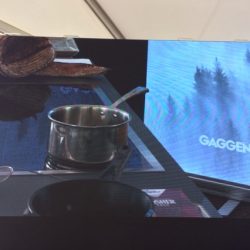 Have you ever made a tater tot? Here’s how. Grate super starchy potatoes, Idaho’s are best, and cook them in a pot of hot duck fat until they become a “giant gloppy starchy mess,” according to Kinch. When soft, you drain them, put them in a bowl and season them with salt, fresh thyme or rosemary and grated lemon rind. Reaching for the pepper mill, he said, “Is anyone else here left-handed? Do you feel discriminated against by pepper mills?”
Have you ever made a tater tot? Here’s how. Grate super starchy potatoes, Idaho’s are best, and cook them in a pot of hot duck fat until they become a “giant gloppy starchy mess,” according to Kinch. When soft, you drain them, put them in a bowl and season them with salt, fresh thyme or rosemary and grated lemon rind. Reaching for the pepper mill, he said, “Is anyone else here left-handed? Do you feel discriminated against by pepper mills?”
Once seasoned, you press the glop onto a parchment lined cookie pan, put another sheet on top, press a duplicate cookie pan on top of that, along with a weight. He used a box of Kosher salt. Refrigerate overnight until the “dough” is firm. Then put it on a board and cut it into strips about 1 inch wide. Cut those into logs about 2 inches long and fry in a mixture of duck fat and olive oil, until golden brown. “Don’t overload the pan!” he warned. “Don’t let them touch!” Keep the tots warm in an oven while you cook the entire batch.
Asked what he does with the duck fat after cooking, Kinch replied, “I reuse it. It gets better every time, especially after you make duck confit.”
Kinch took a moment to explain the benefits—and downsides—of the German-made Gaggenau induction stove he was using. The big benefit is you put a pot on the surface and it automatically recognizes the pot’s outline, and allows you to control the exact heat you want to that surface only. You have to use pans especially designed for induction stoves, but Kinch says they last forever if you care for them properly. The downside to induction stoves? They run on electricity, which compared to natural gas is relatively expensive here in the United States. While cheap, though, gas is hugely wasteful.
“With gas stoves, half the energy goes away immediately. It is lost as heat,” he explained. This huge heat loss makes kitchens ungodly hot and requires the use of venting hoods. It’s a terribly inefficient way to cook, which is why, in Europe, where gas is egregiously expensive (except in Russia), professional kitchens all use induction technology.
“Induction directs all the energy directly to the pot, allowing you to maintain control of the temperature,” Kinch explained. “Cooking is all about fire and water, literally. You are controlling the evaporation of water with heat.”
Asked if he would use induction stoves at Manresa, he answered, “In a heartbeat, if I didn’t have to pay for the electricity!”
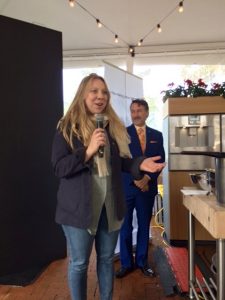
Asked by Gourmet Fest organizer, David Fink, about what it meant for Manresa to go from 2 Michelin stars to 3, Kinch answered, “You can’t cook for awards or accolades. You have to do your thing. Michelin is a good guide. The demographic of our visitors has completely changed. We’re not in a major metropolitan area in Los Gatos: we’re essentially a distant suburb of San Jose. Before we got 3 stars, 50% of our business was repeat customers. Since then, almost all our visitors are first time, every night. 50% of them are from out of state. Many from Europe, Japan and other parts of Asia. They’re traveling to reach us! It’s astonishing! Having 3 Michelin stars is a superlatively powerful force.” He added, “Our regulars still know how to get a table, though.”
We were also treated to a taste of beautiful sourdough bread baked by Manresa Bread maven Avery Ruzicka, who told the crowd she was about to go into production mode on her seasonal cherry and pistachio Panettone, just in time for Easter. She explained that they use only organic flour for all their breads, mostly milled in-house, using a new stone mill from Vermont. Manresa breads are all sourdough-fermented over at least three days, making them very hearty and long-lasting.
And mark your calendars folks, GourmetFest 2019 will be held March 14—17 next year, in beautiful Carmel-by-the-Sea.
Some highlights from the closing dinner of GourmetFest 2018
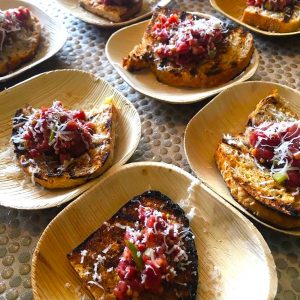
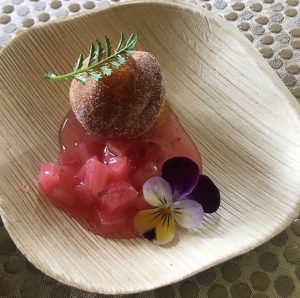
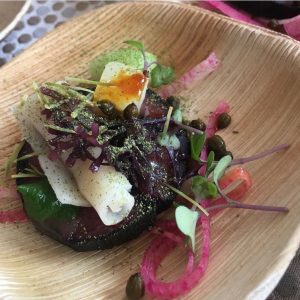
About the author
Laura Ness is a longtime wine journalist, columnist and judge who contributes regularly to Edible Monterey Bay, Spirited, WineOh.Tv, Los Gatos Magazine and Wine Industry Network, and a variety of consumer publications. Her passion is telling stories about the intriguing characters who inhabit the fascinating world of wine and food.
- Laura Nesshttps://www.ediblemontereybay.com/author/lness/
- Laura Nesshttps://www.ediblemontereybay.com/author/lness/
- Laura Nesshttps://www.ediblemontereybay.com/author/lness/
- Laura Nesshttps://www.ediblemontereybay.com/author/lness/


